Just looking for our Best Dog Training Website examples list?
Why Your Dog Training Website Could Be Costing You Clients
Your website is more than just an online brochure—it’s often the first interaction potential clients have with your dog training business. And first impressions matter.
A dated layout, poor gateways, or cookie-cutter template can send the wrong signal about your professionalism and expertise. In a competitive market where pet owners are researching services online before picking up the phone, your online presence must reflect the trust, care, and results you provide in person.
Whether you’re building a new website from scratch or upgrading your current one, great web design is a non-negotiable tool for success. It’s how you showcase your brand, differentiate from local competitors, and convert browsers into bookings. The right design can turn your website into a lead-generating engine—fueling your calendar with new client inquiries and positioning you as the trainer of choice in your area.
This guide will walk you through exactly how to make that happen. From strategic layout principles to SEO, conversion tactics, and real-world examples, we’ll show you how to build a high-performance website that supports your marketing service goals and sets your dog training business up for lasting growth.
Website Planning & Purpose: Laying the Foundation for Success
Before choosing a color scheme or drafting a layout, the most important step in building a high-performing website is proper planning. Without a clear strategy, even the best-looking site can fail to attract or convert potential clients.
The planning phase for a dog training business begins with understanding your unique value as a trainer. Are you focused on obedience, behavior correction, puppy training, or specialty services? Each niche requires different content, calls-to-action, and user flows. Your website should reflect what makes your brand distinctive while guiding visitors to take the next step—whether that’s booking a session, scheduling a consultation, or learning more about your philosophy.
Start by outlining clear goals. Do you want to generate more leads? Showcase success stories? Educate your audience with blog content? Clarifying your objectives helps shape the structure and content of the site. For example, a trainer who offers group classes might prioritize a class schedule calendar, while a behavior specialist may focus more on educational resources and testimonials.
Next, consider your users. Pet owners visiting your site are likely in problem-solving mode. They need to quickly see that you understand their challenges and can deliver results. This means intuitive design, mobile responsiveness, and trust-building elements must all be part of your initial plan—not afterthoughts.
Planning also means creating a content roadmap: What pages do you need? How will your service offerings be presented? What calls-to-action will appear on each page? How will you build trust and demonstrate credibility?
For a deeper breakdown of essential web design fundamentals that apply across all industries—including dog training—check out our guide on the core principles of web design.
Investing the time upfront to define your purpose, audience, and structure ensures your website looks professional and performs like a true marketing asset from day one.
Design Principles That Build Trust and Convert Visitors
Effective website design isn’t just about looking good—it’s about making every interaction intuitive, clear, and reassuring for pet owners. Dog trainers need websites that guide users smoothly from the first click to a booked appointment. That requires more than flashy visuals. It requires purposeful design choices that build trust and drive action.
Start with visual hierarchy. Your homepage should immediately communicate who you are, what you do, and how a visitor can take the next step. A strong hero section with a headline, subheadline, and clear call-to-action (CTA) sets the tone. Use bold headings, ample white space, and strategic imagery to draw attention to key sections—such as your services, customer feedback, and booking form.
Next, prioritize consistent branding. Use your color palette, logo, and typography to convey professionalism and reliability. Whether you’re a behavior specialist or a general dog trainer, your brand should visually reinforce your expertise. Every design element should align with your identity to create a cohesive and memorable impression.
Responsiveness is essential. Most dog owners will visit your site on their phones—while at the park, in a vet’s office, or searching for help with a behavioral issue. Your layout should adapt seamlessly to all devices, with buttons large enough to tap, text that’s easy to read, and CTAs that remain visible without overwhelming the user.
Navigation should be simple and direct. Stick to 5-7 top-level menu items, with clear page labels like “Services,” “About,” “Book a Session,” and “FAQs.” Don’t bury key pages—make it easy for users to find what they need in seconds. Confusion leads to frustration, and frustrated users leave without converting.
Use authentic imagery wherever possible. Avoid stock photos of generic dogs. Instead, feature real photos from training sessions, client reviews, and before/after success stories. This builds emotional trust and demonstrates results.
For more visual inspiration and ideas drawn from high-performing pet industry sites, explore our curated roundup of the best pet care websites.
By applying these core design principles, your website won’t just look polished—it will function as a powerful lead-generation tool that reflects your values, engages visitors, and supports long-term business growth.
Content & Navigation That Drives Engagement and Bookings
A well-structured website makes it effortless for visitors to find what they’re looking for and encourages them to take action. This means showcasing your services clearly, explaining your approach, and removing any obstacles that might prevent a pet owner from reaching out.
Start with your main menu. Keep it clean and intuitive—ideally, no more than 5 to 7 items. The essential pages should include: Home, About, Services, Testimonials, Blog (optional), and Contact. Use straightforward language. Avoid vague labels like “Solutions” or “Experience.” Pet owners want clarity, not guesswork.
Each page should have a clear purpose and call-to-action. Your homepage must establish trust immediately with a concise headline, a short explainer of your unique training approach, a CTA button (“Book a Free Consultation”), and a visual cue to scroll for more. The goal is to answer, “Is this trainer a good fit for me?” within the first few seconds.
Your services page should list each offering—puppy training, behavior correction, private lessons—with a short description, pricing (if applicable), and direct links to book or inquire. Use collapsible sections or icon-based cards to avoid overwhelming the reader.
The about page should introduce you as a real human who cares about dogs and knows how to help. Share your training background, certifications, and personal story. This builds trust and distinguishes you from generic franchises or faceless sites.
A dedicated testimonials page or strategically placed review sections help reinforce credibility. Include photos or even video clips from satisfied clients if possible. Don’t wait until the bottom of a page—embed social proof near service descriptions and CTAs to reinforce decision-making.
For blog content, focus on solving real client problems: “How to stop a dog from pulling on a leash,” “What to expect at your first training session,” or “Is group or private training right for your dog?” Blog posts can improve SEO while showcasing your expertise and deepening trust with prospective clients.
Finally, your contact page should do more than list a phone number. Include a short form, clear business hours, a map (if you offer in-person services), and a brief reassurance like “We respond within 24 hours.” Make it easy and inviting to connect.
By keeping your navigation simple and your content purposeful, you help pet owners find what they need quickly—building confidence, reducing friction, and turning visitors into loyal clients.
Visual Elements That Strengthen Brand and Build User Trust
In website design, visual elements are more than decoration—they’re tools for clarity, credibility, and conversion. A strong visual experience helps visitors understand your brand instantly and builds trust at first glance.
Start with high-quality photography. Real images of you working with dogs convey authenticity and warmth. Avoid generic stock photos that feel impersonal. Use pictures that show different types of training scenarios: leash work, puppy socialization, one-on-one sessions, and happy clients. This reinforces your brand personality and helps visitors imagine their own success with you as their leader.
Color palette plays a subtle yet powerful role in how your brand is perceived. Use calming colors like blues and neutrals to convey trust and reliability, or earth tones and greens to reflect a natural, down-to-earth vibe. Avoid overly bright or clashing tones that create visual noise or distract from the message.
Typography must be clean and legible. Use a professional sans-serif font for body copy and a bolder, complementary font for headings. Keep it consistent across the site. Clear text reinforces professionalism and allows users to scan content easily, especially on mobile.
Whitespace—the space around text and images—is crucial. It gives your content room to breathe and reduces visual clutter. A spacious layout keeps the site feeling calm and user-friendly, which is especially important for pet owners who may already be overwhelmed trying to solve behavioral issues.
Icons and graphics can guide the user through complex topics. Use custom icons to represent training services, age groups (puppies, adults), or behavior issues (barking, jumping, aggression). This improves comprehension and adds visual interest without overloading the page.
Videos are especially effective in this industry. A short video clip on your homepage showing a session in progress, or a client testimonial in action, can dramatically boost trust and engagement. Videos also give users a better feel for your tone, method, and results.
Finally, design elements like badges, certifications, and media mentions help solidify your authority. These visuals can be placed near your bio or in a trust strip under your services section. Always align visual choices with your brand message—are you approachable and friendly, or structured and results-driven? Every element should reflect that.
When thoughtfully integrated, visual design transforms your website from a static brochure into a compelling digital experience that speaks directly to your audience, earns trust, and supports their decision to choose you as their dog trainer.
Ongoing WordPress Maintenance for a Reliable Website
Once your website is live, the work isn’t over. Ongoing WordPress maintenance is essential to keep your site fast, secure, and functioning smoothly. Just like a well-trained dog needs regular reinforcement, a high-performing website needs consistent upkeep.
Updates are the first priority. WordPress core, plugins, and themes are frequently updated to patch security holes and improve performance. Ignoring updates can make your site vulnerable to hacks or cause compatibility issues that break features. Regularly applying updates keeps everything running efficiently and minimizes risk.
Security monitoring should be part of your maintenance plan. Dog trainers collect sensitive information through contact forms and client booking tools—email addresses, phone numbers, and sometimes payment data. Implementing malware scanning, firewall protection, and login monitoring helps protect your site and your clients’ trust.
Backups are non-negotiable. Automated daily backups ensure that if something does go wrong—a failed update, a plugin conflict, or accidental deletion—you can restore your site quickly. A reliable backup strategy prevents downtime and protects your investment.
Performance tuning is another important aspect of WordPress maintenance. Over time, sites can slow down due to bloated plugins, unoptimized images, or outdated code. A slow site frustrates users and hurts your Google rankings. Regular speed checks, image compression, and database optimization keep your site loading quickly on all devices.
Broken links, outdated content, and formatting glitches also creep in without regular attention. A consistent maintenance routine includes monthly site reviews to identify and fix these issues before they cost you traffic or credibility.
If you rely on features like scheduling tools, payment integration, or contact forms, those components must be tested routinely. A single broken form can mean missed leads and lost revenue. Regular functionality testing ensures that the tools you depend on to run your business work every time a potential client visits.
WordPress websites are powerful, but they’re not set-it-and-forget-it platforms. Consistent maintenance ensures your website continues to reflect your professionalism, performs at its best, and supports your business as it grows.
Best Dog Training Website Design Examples
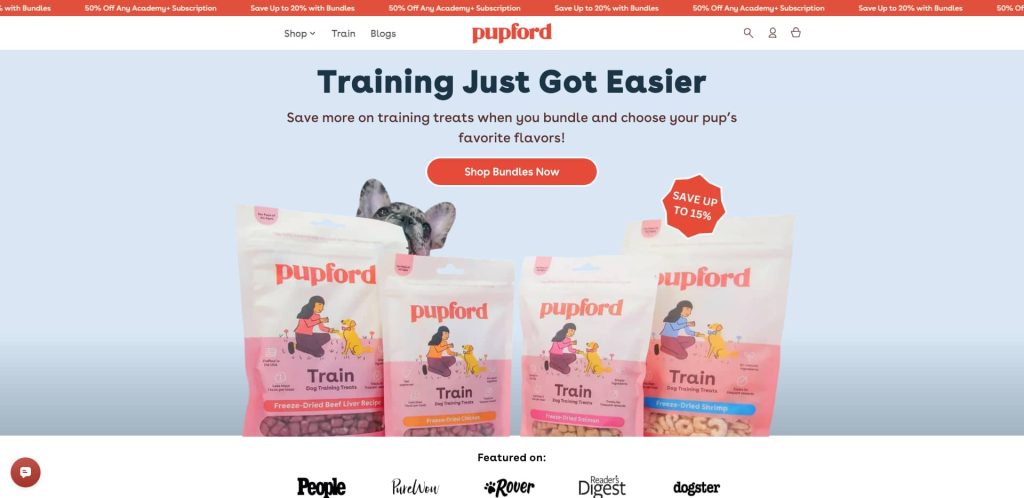
1. Pupford
Location: Phoenix, AZ
Key Takeaways:
- Clean, modern design with bold CTAs for training tips and products.
- Seamless integration of courses and e-commerce.
- Real success stories front and center, enhancing trust.
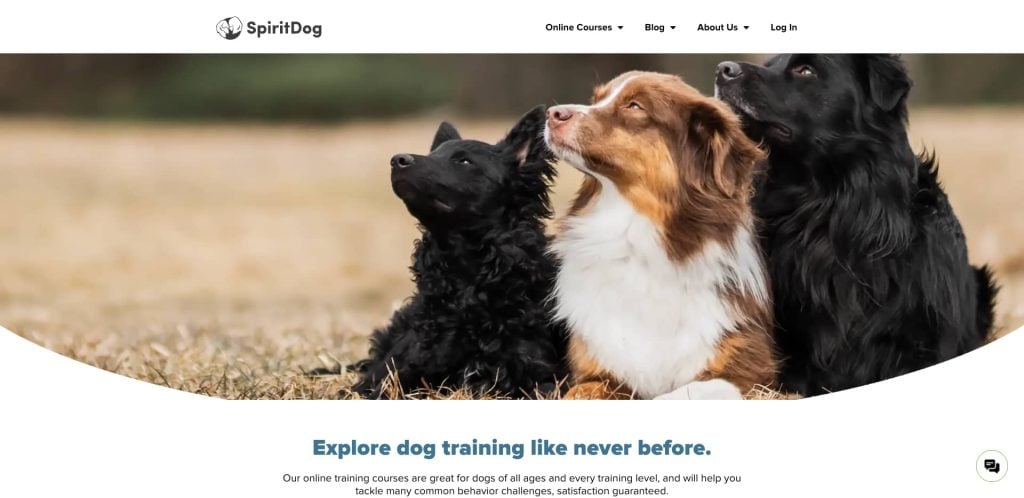
2. SpiritDog Training
- Structured course pages with video demos.
- Bright, friendly layout reflecting positive reinforcement philosophy.
- FAQ section streamlines user decisions.
Location: Denver, CO
Key Takeaways:

3. Karen Pryor Academy
Location: San Rafael, CA
Key Takeaways:
- Authority-building visuals and in-depth course info.
- Interactive map for workshop locations.
- Balanced blend of scientific and approachable content.
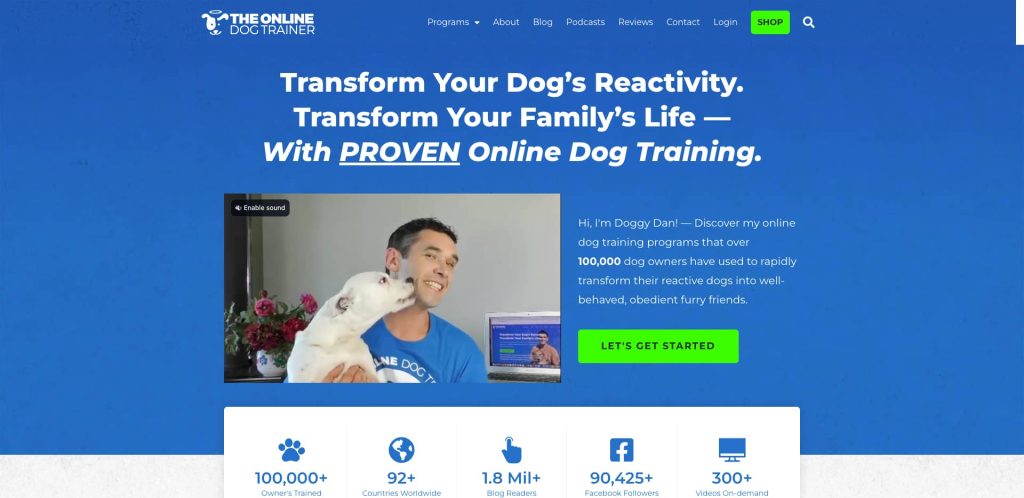
4. The Online Dog Trainer
Location: Orlando, FL
Key Takeaways:
- Membership model is clearly explained with pricing.
- Homepage videos showcase training style.
- Soothing color palette tailored to anxious dog owners.
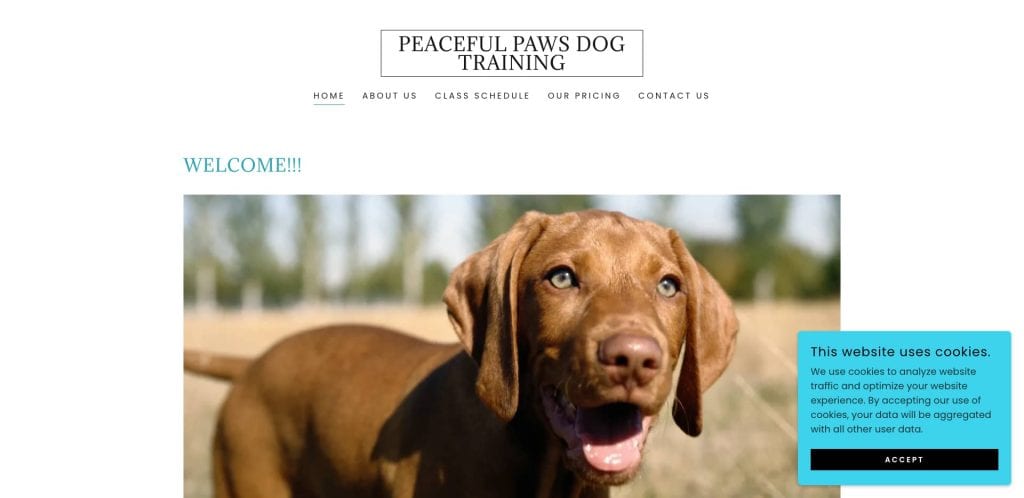
5. Peaceful Paws Dog Training
Location: Portland, OR
Key Takeaways:
- Soft visuals match a gentle training approach.
- Service categories are neatly displayed in the hero area.
- Embedded client videos humanize the brand.
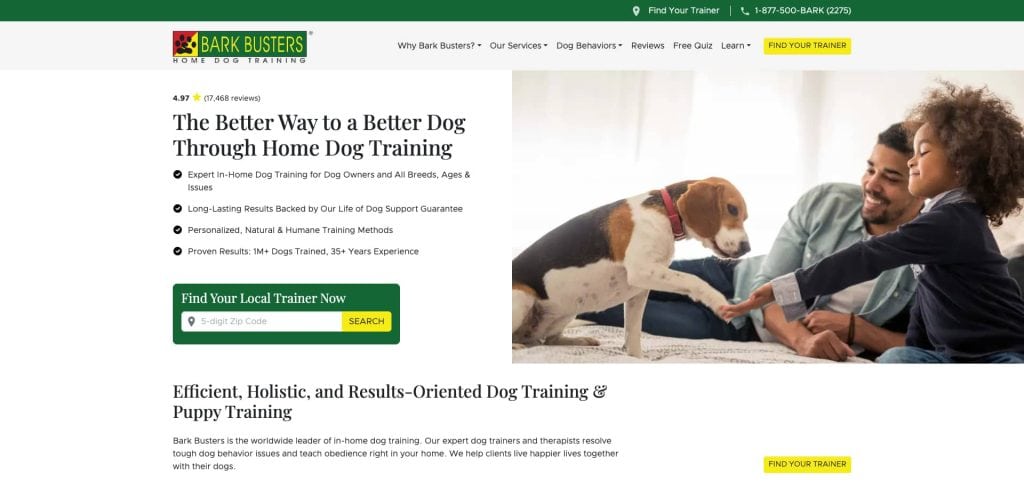
6. Bark Busters
Location: Danville, CA
Key Takeaways:
- Global reach via a locator map for local trainers.
- Clear distinctions between puppy and obedience programs.
- Regional testimonials reinforce credibility.
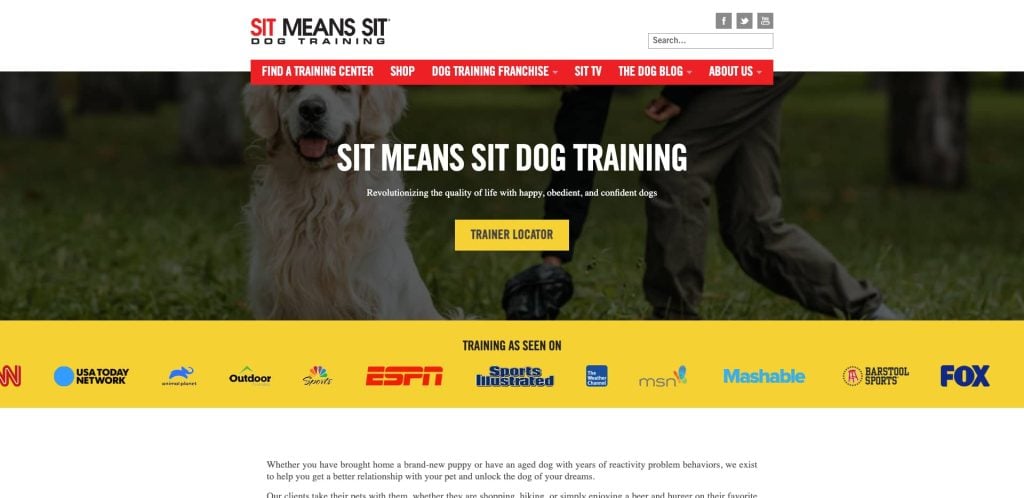
7. Sit Means Sit
Location: Paradise, NV
Key Takeaways:
- Unified branding across franchises with schedule access.
- Product pages for remote collars.
- Video library demonstrates training methods.
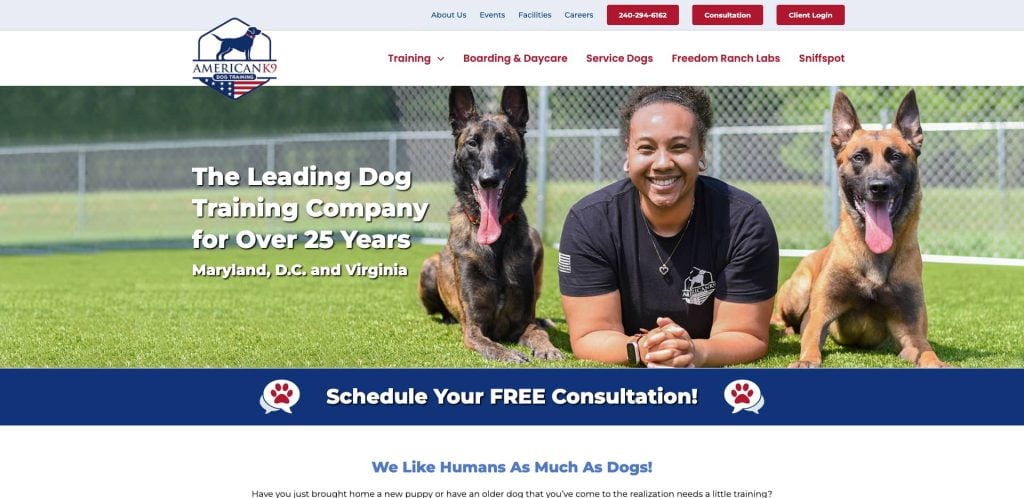
8. American Alpha K9 Training
Location: New York, NY
Key Takeaways:
- Professional homepage focused on obedience.
- Easy navigation to services and contact.
- Detailed trainer profiles build trust.
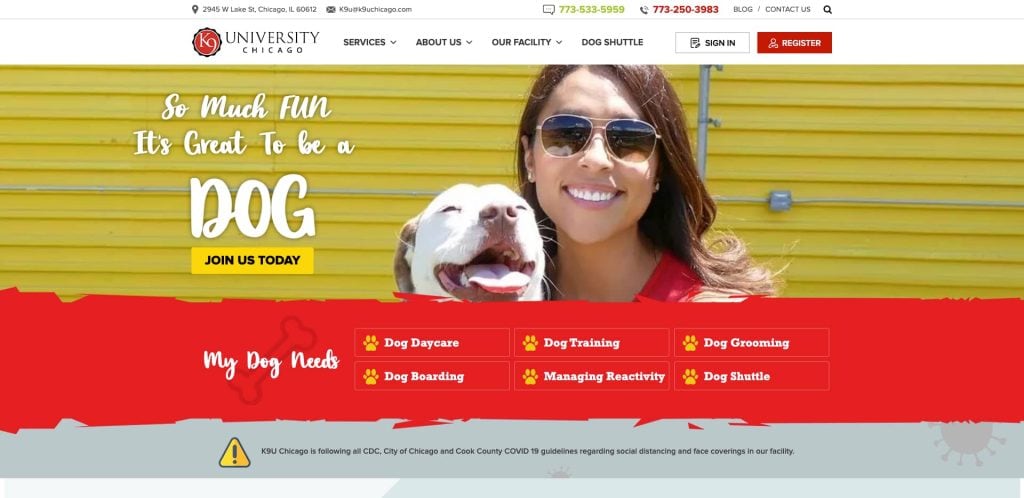
9. K9 University
Location: Chicago, IL
Key Takeaways:
- Hero image reflects hands-on training.
- Contrasting CTA drives engagement.
- Logical flow from overview to booking.
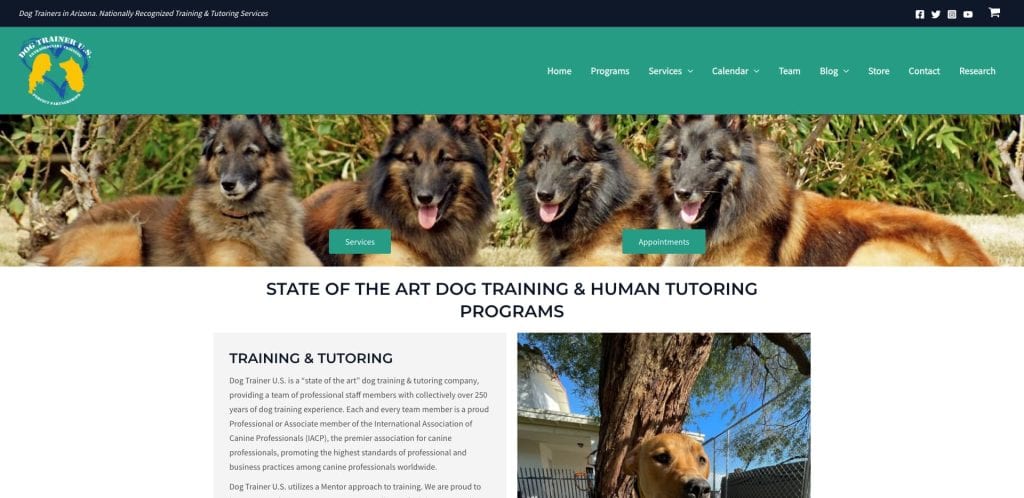
10. Dog Trainer US
Location: Miami, FL
Key Takeaways:
- Breed-focused design with streamlined layout.
- Integrated shop supports both products and services.
- Social links and calendar keep traffic engaged.

11. Ultimate Canine Training
Location: San Diego, CA
Key Takeaways:
- Combined training and dog placement services.
- Prominent “Donate” button adds community trust.
- Organized portfolio of dogs and offerings.
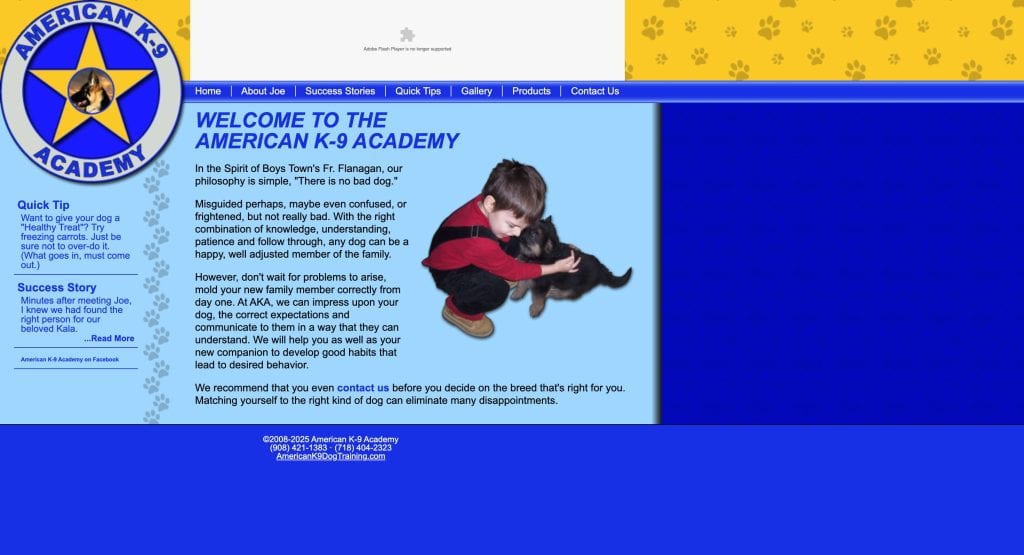
12. American K9 Dog Training
Location: Atlanta, GA
Key Takeaways:
- Trainer-dog imagery reinforces expertise.
- Clean menu structure with media content.
- Family-appeal messaging emphasizes harmony.
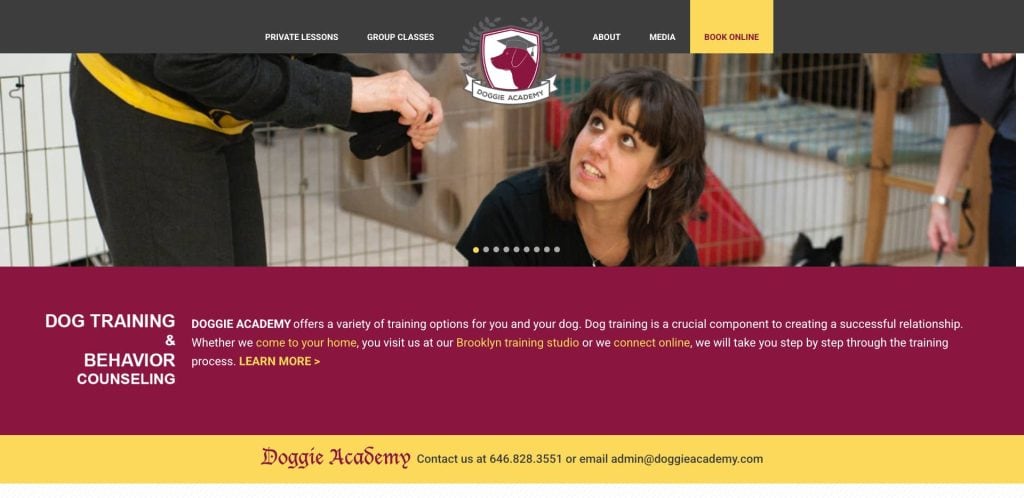
13. Doggie Academy
Location: Austin, TX
Key Takeaways:
- Warm maroon-and-yellow design feels inviting.
- User-friendly interface for all ages.
- Transparent pricing and class information.
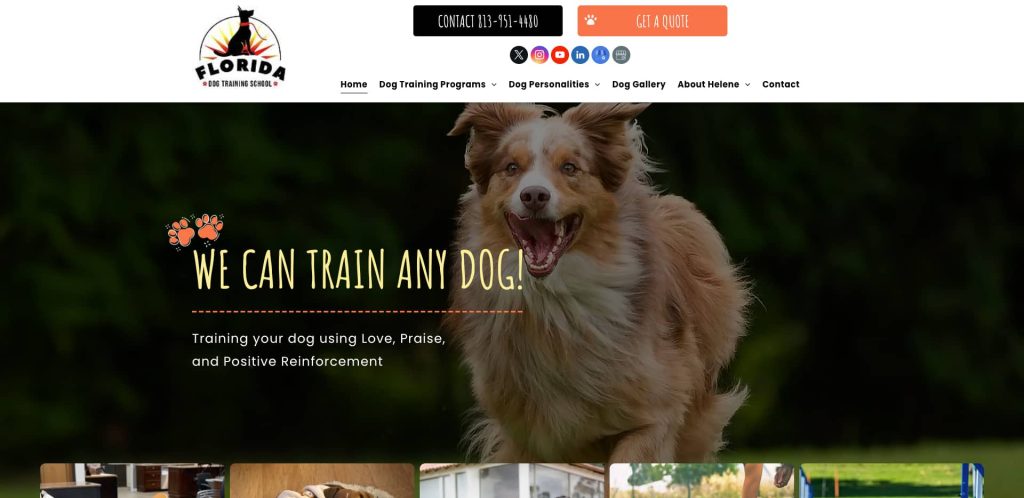
14. Florida Dog Training School
Location: Miami, FL
Key Takeaways:
- Vibrant homepage aligns with local branding.
- Easily accessible menus and contact info.
- Regional focus adds local trust appeal.
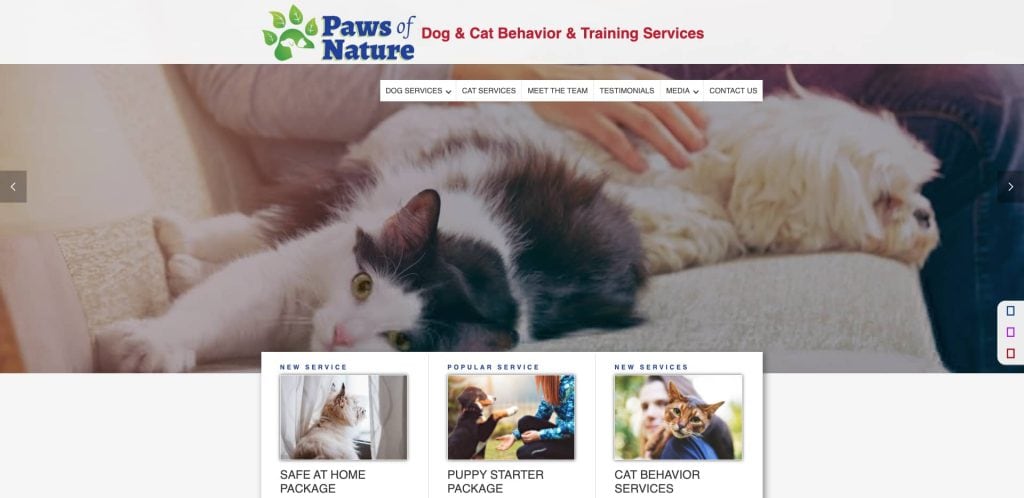
15. Paws of Nature Dog & Cat Behavior
Location: Seattle, WA
Key Takeaways:
- Minimalist Webflow design with animations.
- CMS-driven layout for services and blog.
- Clean aesthetic suitable for cloning inspiration.
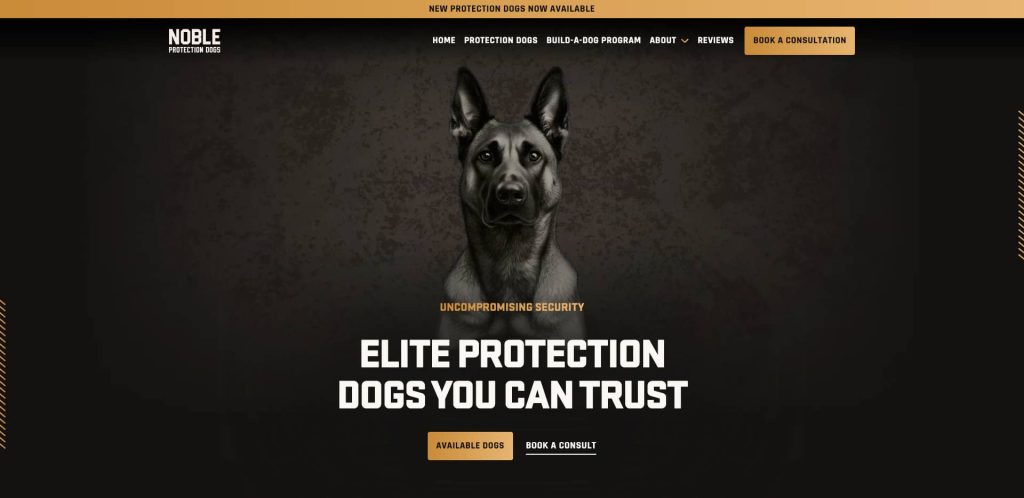
16. Noble Protection Dogs
Location: Houston, TX
Key Takeaways:
- Strong imagery supports protective dog training.
- Navigation spans obedience to protection programs.
- Persistent booking prompts on all pages.
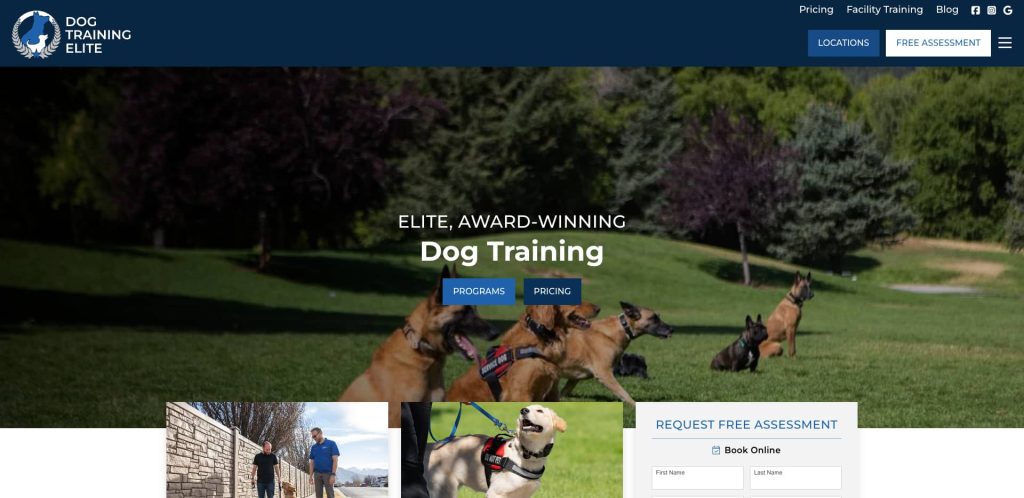
17. Dog Training Elite
Location: Multiple U.S. cities (HQ: Austin, TX)
Key Takeaways:
- Offers free assessments prominently
- Structured training programs: puppy, obedience, aggression
- Award-winning branding enhances trust
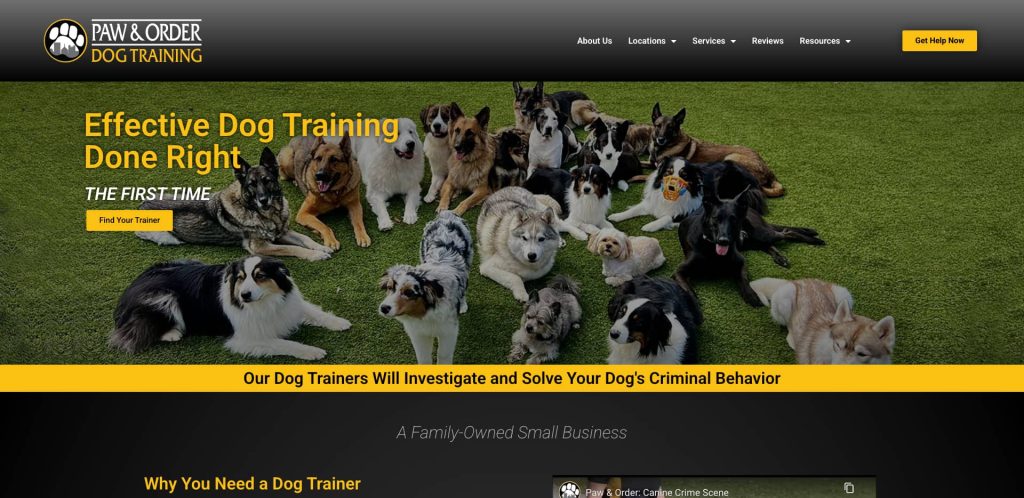
18. Paw & Order
Location: Simpsonville, SC
Key Takeaways:
- Offers in-home and group training programs, including Canine Good Citizen and therapy-dog certification
- Strong focus on behavior modification and the owner-dog relationship across multiple regions
- Clean, service-driven website with clear contact methods and training program details
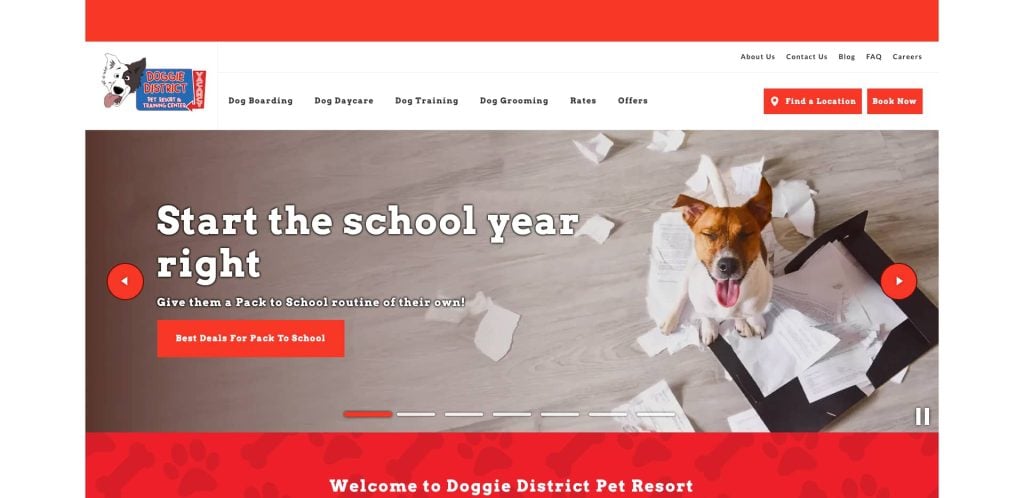
19. Doggie District Pet Resort & Training Center
Location: Las Vegas, NV (also Phoenix, AZ)
Key Takeaways:
- Combines training with daycare, boarding, and grooming services for a one-stop pet care experience
- Trusted, award-winning local brand with loyalty-focused design
- Clear service breakdowns and facility imagery support transparency and bookings
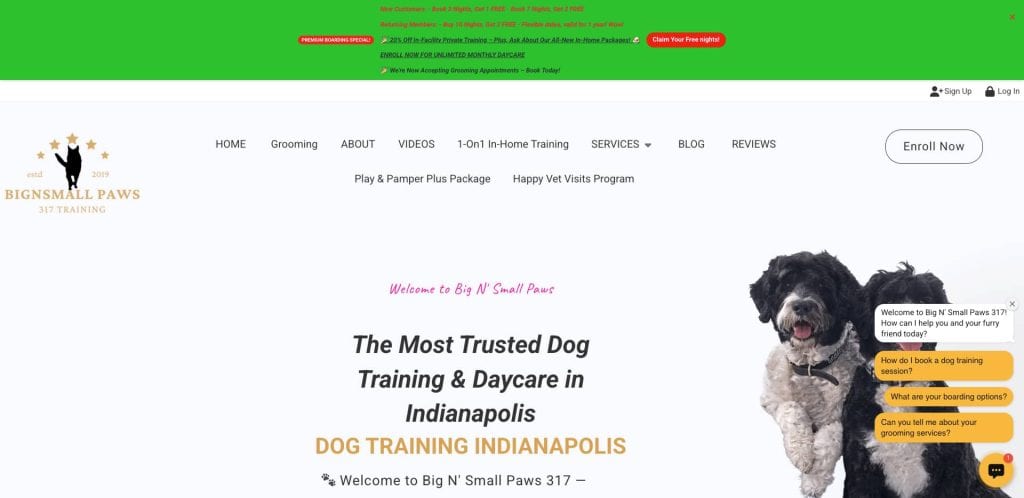
20. Big N’ Small Paws
Location: (Multiple U.S. locations)
Key Takeaways:
- Highly rated board-and-train program with strong customer reviews
- Personalized, empathetic approach reflected in warm branding and approachable site language
- Focused service pages with pricing outlines and clear next-step CTAs to drive bookings
These examples demonstrate a range of effective strategies: engaging multimedia, intuitive navigation, booking integrations, local trust elements, and client-focused content—ideal inspiration for your own outstanding dog training website.
Ready to Build a Website That Reflects Your Training Expertise?
Your website is one of the most powerful marketing and sales tools in your business. Whether you offer group classes, one-on-one sessions, or online courses, your digital presence should reflect the professionalism and care that define your approach to dog training. A clean and professional layout, responsive design, and smart content structure are not just “nice to have”—they’re what it takes to create a website that earns trust and drives results.
If you’re a dog trainer looking to create a stunning online presence, don’t settle for a generic website template. A custom-built, strategic website tailored to your training methods and business goals can make all the difference in how clients view your services and how often they book.
Let’s help you build a great dog pro website part by part—starting with a solid plan. Get in touch with our experts today to start your design project.
Common Questions About Site Design for Dog Trainers, Answered
What are the must-have features for a professional website?
A great site should include a professional and clean home page, clear navigation, mobile responsiveness, and sections for services, testimonials, and contact forms. Additional features include a booking tool, an FAQ section, a blog for training tips, and visuals that reflect your approach to dog training. Highlighting your training programs and canine expertise builds trust and encourages conversions.
Should I use a website builder or hire web designers for my training site?
If you’re just starting and need to launch your first website quickly, a website builder like Squarespace can work. However, for long-term success in the dog training industry, working with professional web designers ensures great design, strategic layout, and SEO optimization. Custom design services help you create a professional and approachable online presence that truly reflects your brand and training solutions.
How should I organize my dog training services on my website?
Your services page should be easy to navigate and list each of your offerings—such as puppy training, group classes, private lessons, or online dog training courses. Group these services into sections with brief descriptions, pricing, and clear calls-to-action. Use headings and icons to make it scannable, and always tie your training classes back to results for your clients and their dogs.
What’s the best way to write website copy for a dog training site?
Website copy should be clear, client-focused, and conversion-driven. Address your audience’s concerns and show how your training methods solve them. Use good copy to highlight benefits, outcomes, and what makes you different. If writing isn’t your strength, consider professional website copywriting to help you create compelling messaging that matches your design and speaks directly to pet owners.
How can I make my site stand out in a competitive market?
Focus on the look and feel of your site, use a professional dog trainer website template or custom design, and include visuals that show your real work—not just stock photos. Incorporate social proof through reviews, before/after success stories, and certifications. Emphasize your unique training programs or specialties (like dog boarding, dog daycare, or dog walking). A modern dog trainer website that communicates a clear value proposition gives a good first impression and helps you create a successful dog brand.
How often should I update the content on my dog training site?
Keep your business website content fresh by updating it monthly or quarterly. This includes adjusting your services, adding new client testimonials, promoting seasonal offers, and blogging about topics relevant to the training industry. New content helps increase website traffic and signals to search engines that your site is active and valuable.
Can I build a website in minutes?
Some tools claim you can build a site in minutes, but a professional website that brings real results takes thoughtful planning. It’s not just about launching fast—it’s about launching right. Custom solutions, strong design skills, and clear messaging make your website an asset, not just a placeholder.
How important is visual design for my website?
Visual design plays a critical role in building trust. A beautiful website with cohesive branding, professional images, and an organized layout makes your services more appealing. Dog professionals referenced in high-performing sites always invest in visuals that reflect their quality. Great design supports user experience and encourages pet parents to engage with your services.
What types of dog professionals benefit from custom websites?
Beyond trainers, custom websites are valuable for anyone in the pet care space—dog daycare providers, pet sitting businesses, dog boarding services, and even those offering dog walking. If you’re offering products and services related to canine care, a strategic website tailored to your audience can significantly increase engagement and conversions.
Can a strong website really impact my business growth?
Yes. A well-built, professional online presence acts as a full-time salesperson for your dog training services. It helps you generate leads, grow your reputation, and provide an excellent first impression. By following best practices in design and content, you can create a website for your dog training business that attracts and converts visitors every day. For support in building your dog training website, our team is ready to help you create the right foundation.



